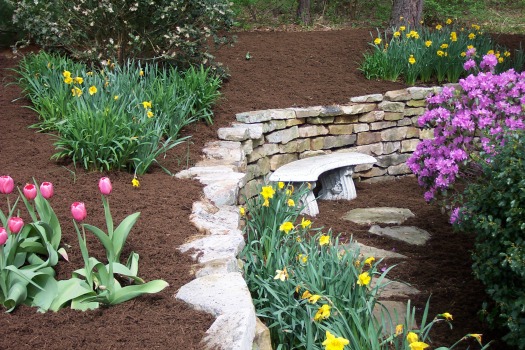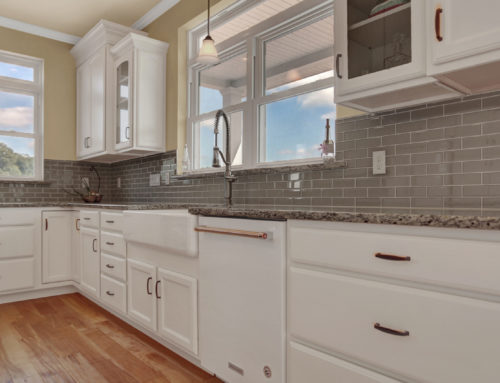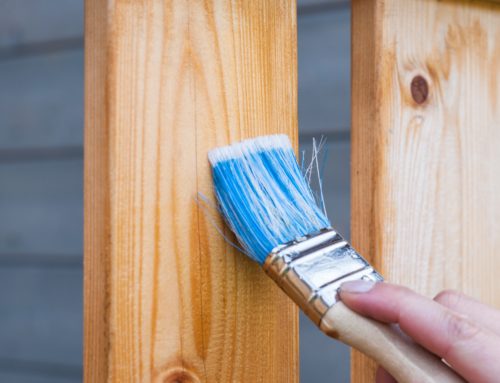By: Dave Toht Reprinted from HouseLogic.com with permission of the NATIONAL ASSOCIATION OF REALTORS®.
Ramp up your curb appeal with cool landscaping projects you can easily pull off in a weekend.
Project #1: Install Rigid Flower Bed Edging
The setup: A crisp edge where the lawn meets the flower beds looks great and eases mowing. Opt for rigid edging — the flexible plastic stuff looks amateurish from day one. Use a charged garden hose to lay out a smooth curve.
Tip: A “charged” garden hose full of water makes for a smoother, kink-free curve; charge up by turning on the spigot but leaving the sprayer off. With the hose as your guide, use a lawn edger or spade to cut away excess sod and make an incision for the edging. Tap in the edging with a rubber mallet and add the stakes. Trim the edging with a hacksaw, using a speed square to mark for cuts.
Specs and cost: Steel — $1.25 per lineal foot; aluminum — $2.25 plf; rigid plastic or fiberglass — $1.65 plf.
Tools: Garden hose, flour or powdered chalk, lawn edger or spade, shovel, speed square, hacksaw, rubber mallet, hammer.
Time: 1 day to edge a typical yard.
Project #2: Add an Earth Berm
The setup: Create an eye-catching front yard feature by shaping a few cubic yards of topsoil into an undulating berm. Topped off with mulch, groundcover, and bushes, a berm adds interest and buffers street noise. Use a charged hose to outline the berm. Remove sod a couple of feet in from the perimeter. Add a few mounds, but max out at 3 feet high.
Specs and cost: Three cubic yards of soil is enough for a good-sized berm. Expect to pay $15-$20 per cubic yard and $15–$60 for delivery — a total of $60-$120.
Tip: Don’t be tempted by those bags of topsoil at the home center: At $2.50 per cubic foot, a cubic yard (27 cubic feet) will end up costing you $67.50. Have a cubic yard of mulch dropped off as well ($15–$20). A dozen periwinkle starts, plus a few boxwood bushes and evergreens, will set you back another $140. Total for an 18-foot-long berm: $215–$280.
Tools: Wheelbarrow, spade, shovel, garden rake, trowel.
Time: A day to form the berm, another half-day for planting and mulching.

Project #3: Build a Wall for a Raised Bed
The setup: A stacked flagstone wall for your raised beds has an old-world look that mellows any landscape. Best of all, you don’t have to be stonemason to build one. Begin by laying out the wall with stakes and mason’s line. Tamp a level bed of sand for the first course. As you add courses, stagger joints at least 3 inches. Set each course back ¼-inch so the wall leans backward slightly. Once finished, back the wall with landscaping fabric before filling with topsoil.
Specs and cost: Choose a stone of consistent thickness. Flagstone might be limestone, sandstone, shale — any rock that splits into slabs. A ton of 2-inch-thick stone is enough for a wall 10 feet long and 12 inches high.
Cost: About $300 for stones and sand.
Tip: Permanent retaining walls should be backed by pea gravel for drainage. In some locations, walls taller than 3 feet high require a building permit.
Tools: Stakes and mason’s line, spade, shovel, a 2-by-4 that’s 8 feet long, a 4-foot level, garden rake, tamper.
Time: 1 day for a 10-foot-long wall that’s 12 inches high.
Project #4: Install a Flagstone Path
The setup: For a welcoming addition to your yard, add a flagstone pathway. Use a charged garden hose to mark a meandering path about 3 feet wide. Arrange flagstones within the path so they are 2–4 inches apart and mark their location with sprinkled flour.
Tip: Sprinkling flour over the stones creates a “shadow” outline on the ground. When you remove the stones, you’ll have perfect outlines for cutting away the sod. Cut away 3–4 inches of sod beneath each stone, add a layer of sand, and level the flagstones as you place them.
Specs and cost: For a 40-foot path about 3 feet wide, plan on 2 tons of flagstones and about a cubic yard of coarse sand. Cost: About $550.
Tools: Garden hose, flour, spade, trowel, level.
Time: 1 day for a 40-foot path.
Project #5: Add a Brick Tree Surround
The setup: Installing a masonry surround for a tree eases mowing and looks great. All it takes is digging a circular trench, adding some sand, and installing brick or stone.
Tip: To create a nice, even circle around the base of your tree, tie a big loop of rope around your tree. Adjust the length of the loop so when you pull it taut, the free end is right where you’d like the outer edge of the surround to be. Set your spade inside the loop with the handle plumb — straight up and down. Now, as you move around the tree, the loop of rope keeps the spade exactly the same distance from the base of the tree, creating a nice circle.
Use the spade to cut into the sod all the way around the tree. Remove the rope, and dig out a circular trench about 8 inches deep and 6 inches wide. Add a layer of sand. Set bricks at an angle for a pleasing saw-tooth effect or lay them end-to-end. Fill the surround with 2–4 inches of mulch.
Specs and cost: This is an instance where buying small quantities of materials at the home center makes sense. Brick pavers cost 50 cents-$1 each — figure about 20 pavers per tree. A bag of mulch, enough for one tree, costs $2.50.
Tools: Rope, spade, trowel.
Time: About 3 hours per tree.
Dave Toht has written or edited over 60 books on home repair and remodeling for The Home Depot, Lowe’s, Better Homes & Gardens, Sunset, and Reader’s Digest. He’s a former contractor with decades of hands-on experience.











